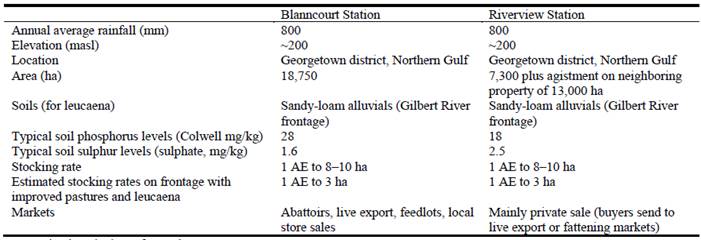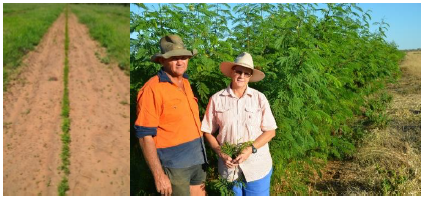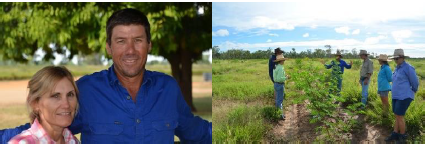Introduction
Introduction and successful establishment of leucaena (Leucaena leucocephala) has the potential to improve annual liveweight gains (LWGs) of grazing cattle in northern Australia, sustainably increase gross margins and mitigate methane production (Harrison et al. 2015). However, leucaena adoption in northern Queensland to date has been low (<2,500 ha established) compared with other regions of the State.
Impediments to leucaena adoption in north Queensland include: (i) poor producer awareness of the productivity benefits of leucaena; (ii) a lack of farming expertise and limited access to suitable machinery; (iii) high establishment costs; (iv) occurrence of psyllid infestations and subsequent leucaena productivity losses; and (v) landscape constraints including low soil fertility, poor soil drainage and standing native timber. This paper describes the efforts of 2 producers to establish leucaena on cleared country adjacent to the Gilbert River (frontage country) in the Northern Gulf Region of Queensland.
Materials and Methods
Leucaena was established recently on 2 family-run breeding enterprises (Blanncourt and Riverview Stations), west of Georgetown in the Queensland Gulf Region, on previously cleared alluvial soils adjacent to the Gilbert River. Background enterprise details are outlined in Table 1 and both operations can be characterized as being well managed by progressive producers with previous farming experience and access to machinery. At Blanncourt, 54 ha of leucaena was established during the 2015/16 wet season (after a failed attempt the previous year), while 160 ha was sown at Riverview during the 2017/18 wet season.
Table 1 Enterprise characteristics of properties where leucaena has been established on Gilbert River frontage country.

AE = animal equivalent of ~450 kg steer.
At Blanncourt, the paddock was deep-ripped in October 2014 and 2 m cultivated strips prepared at 10 m spacing. Superphosphate (8% P, 11% S) was applied (250 kg/ha) along the whole strip. Wondergraze was sown (1.5 kg/ha) in single rows in the 2014/15 wet season (December) after 55 mm rainfall. Spinnaker® (700 g/kg imazethapyr) was applied at the time of sowing at 70 g/ha. Verdict® (520 g/L haloxyfop) at 300 mL/ha was used for post-emergent grass control. Dictate (480 g/L bentazone) at 2 L/ha was also used on some rows for broad-leaf weed control. Plants on less than 5 ha survived due to strong competition from nut grass (Cyperus esculentus) and low rainfall (only ~250 mm received over the wet season). The majority of the site required re-sowing due to poor emergence and lack of follow-up rain. In the 2015/16 year, plant strips were cutter-barred (bulldozer rippers inserted in ground and a connecting bar between the ripper boots severs woody regrowth and nutgrass roots and rhizomes to a depth of 300 mm approx.) in September. While this was effective, nitrogen mineralization from cutter-barring encouraged heavy broad-leaf weed growth. Cultivation of the strips with disc and tyned implements over the October/November period was used for weed control. Rainfall (75 mm) in December 2015 allowed planting in late December, with Spinnaker® (100 g/ha) again applied as a pre-emergent weedicide and Dictate® (2 L/ha) was used for broad-leaf weed control after leucaena emergence. Verdict® (300 mL/ha) was also applied to control grasses, although 2 additional cultivations were performed after sowing. Granulated sulphur (90% S; 50 kg/ha) was applied over the plant rows once establishment was assured.
At Riverview, the paddock was cutter-barred in September 2017 to control nut grass and woody weeds and several subsequent cultivations developed a fine seedbed. Superphosphate (250 kg/ha) and granulated sulphur (70 kg/ha) were applied over 3 m of the planting strip. Unusually heavy rain (120 mm) in October negated the effectiveness of the cutter-barring and re-invigorated growth of nut grass. The December/January period was then hot (>35(C) and dry. After re-cultivating in December, some planting was possible in January 2018 but was compromised by competition from weeds and set-up issues with a new twin-row planter. Sowing was done mostly in February, with 150 ha of cv. Wondergraze and 10 ha of cv. Redlands planted at 1.5 kg/ha seeding rate. Immediately after sowing, Vezir® (700 g/kg imazethapyr) at 140 g/ha and glyphosate (570 g/L) at 2 L/ha were applied in a mix for knockdown and pre-emergent weed control. Persistently wet conditions prevented timely weed control post-sowing. Cultivation was not possible but Sempra® (750g/kg halosulfuron-methyl) at 100 g/ha and Verdict® at 300 mL/ha combined with a wetting agent (Banjo®, 725 g/L methyl ester) were applied as a mix during March. By April problems were being experienced in some areas with termites eating young leucaena stems. A ground-based application of Regent® (200 g/L fipronil) at 100 mL/ha was made over the plant rows in an attempt to control termites.
Results
Overall establishment success at Blanncourt was ~75% across the paddock as a whole after the second year planting. Soils varied across one end of the paddock with heavier clay loams in low areas. Leucaena germination was usually satisfactory in these areas but emergence or subsequent establishment was poor due to soil surface crusting, poor drainage and heavy weed competition. Leucaena establishment across the remainder of the paddock (more even loamy soils with better drainage) was very favorable. The pre-emergent herbicide applied at sowing was ineffective, although grasses were well controlled with Verdict®. Cattle were introduced to the paddock in July 2016, when leucaena was about 2 m high. No animal performance data have been collected to date.
At Riverview, establishment success was approximately 65% across the paddock as a whole. Some areas of the paddock had full establishment, while other areas had patchy establishment due to variable soil characteristics, seed blockage issues during sowing and termite damage post-planting. The herbicide mix of glyphosate and Vezir® applied at sowing was only partially effective as both a knock-down and pre-emergent treatment due to the hot and dry conditions. Persistently wet conditions later in February then prevented timely weed control, leading to strong competition with young leucaena in many areas. The mixed herbicide application in March caused some yellowing of leucaena (leaf) but it recovered within a few weeks. This was attributed to the Sempra®, as such damage has not previously been observed with Verdict®. Cattle commenced grazing in August 2018 (232 head averaging 229 kg on the 160 ha). No animal performance data have been collected to date.
Discussion and Conclusions
While these areas are limited in extent, establishing leucaena on cleared frontage country in northern Queensland is a significant opportunity for producers with access to this land type to improve productivity. Fertility limitations of these soils can be overcome economically with fertilizer applications but weed control and climate variability remain significant challenges to reliable leucaena establishment. Experiences at Blanncourt and Riverview have highlighted ongoing issues with regard to effective weed and pest control. Some options for improving weed control include slashing or mowing and increased cultivation (post-sowing), increased rates of pre-emergent herbicide (risky) and establishing buffel first (to out-compete broad-leaf weeds), then sowing leucaena into sprayed-out or cultivated strips. Pests (grasshoppers, termites and wallabies) can exert significant pressure on young leucaena plants and are unpredictable and expensive to control.
Nonetheless, successful establishment at Blanncourt and Riverview has demonstrated that motivated producers can successfully establish leucaena on frontage country in north Queensland (Figures 1 and 2). Owners of both enterprises are planning to establish a further 600 ha of leucaena over the 2018/19 wet season.

Figure 1 Leucaena planted in single strip row on Blanncourt (left) and Ronny and Colleen Henry with a double-row planting (right) on Riverview station.
















